Heading
Full-body workouts are an excellent way to enhance your overall fitness and health. By engaging multiple muscle groups in each session, you can maximize calorie burn, improve cardiovascular health, and build strength efficiently. These workouts are perfect for anyone, from beginners to advanced fitness enthusiasts, offering a balanced approach that targets the entire body.
These workouts ensure even muscle development, reduce the risk of injury and improve overall functional fitness. Full-body routines can be tailored for any fitness level and are efficient, often fitting into shorter timeframes while delivering comprehensive benefits. They also support cardiovascular health, increase calorie burn, and promote a leaner physique by maximizing workout efficiency.
The Benefits of Full-Body Workouts
Efficiency:
Full-body workouts maximize time efficiency by targeting multiple muscle groups in a single session, making them ideal for busy schedules.
Balanced Muscle Development:
These workouts ensure even muscle growth and prevent muscle imbalances, which can reduce the risk of injury and improve overall strength and coordination.
Increased Calorie Burn:
By engaging several muscle groups at once, full-body workouts elevate the heart rate and boost metabolism, aiding in fat loss and weight management.
Improved Cardiovascular Health:
The combination of strength and aerobic exercises enhances cardiovascular fitness, promoting heart health and endurance.
Versatility:
Full-body routines can be easily modified for different fitness levels and goals, making them suitable for beginners and advanced athletes alike.
Functional Fitness:
These workouts improve overall functional fitness, enhancing everyday movements and activities by training the body to work as a cohesive unit.
Enhanced Recovery:
Spreading the workload across different muscle groups allows for better recovery between workouts, reducing the risk of overtraining and promoting long-term fitness progress.
Who can use full-body workouts?
Our full-body workouts are ideal for beginners, busy professionals, fitness enthusiasts, athletes, seniors, weight loss seekers, home exercisers, and those in rehabilitation. These routines offer balanced muscle development, efficiency, and versatility, catering to various fitness levels and goals for a comprehensive and effective exercise regimen.
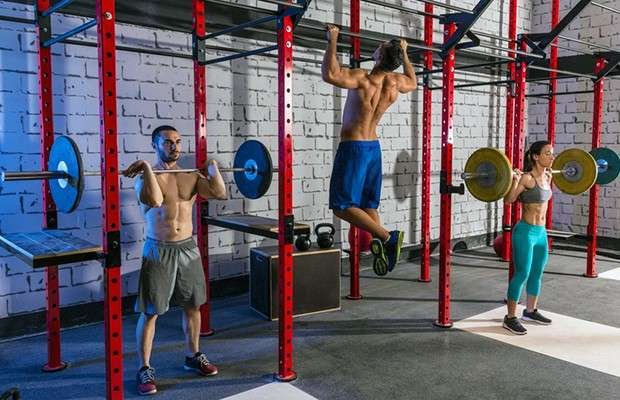
Beginners:
Those new to fitness can benefit from the balanced approach of full-body workouts, which help build foundational strength and improve overall fitness levels.
Busy Professionals:
Individuals with limited time can maximize their workout efficiency by engaging multiple muscle groups in each session, fitting comprehensive exercise into a busy schedule.
Fitness Enthusiasts:
Regular exercisers looking to maintain or enhance their fitness can enjoy the variety and comprehensive benefits of full-body routines.
Athletes:
Sportspeople can use full-body workouts to improve overall strength, coordination, and functional fitness, enhancing performance in their specific sports.
Seniors:
Older adults can benefit from full-body workouts to maintain muscle mass, improve balance, and support overall mobility and health.
Weight Loss Seekers:
Individuals aiming to lose weight can take advantage of the increased calorie burn and metabolic boost provided by full-body exercises.
Home Exercisers:
Those preferring to work out at home can perform full-body workouts with minimal equipment, making them accessible and convenient.
Rehabilitation Clients:
People recovering from injuries (under professional guidance) can use tailored full-body workouts to regain strength and functionality.
The Best Full-Body Exercises
The best full-body exercises include squats, deadlifts, push-ups, pull-ups, lunges, burpees, planks, rowing, kettlebell swings, and mountain climbers. These exercises engage multiple muscle groups, boost strength, enhance cardiovascular fitness, and improve coordination, offering a comprehensive and efficient workout for overall fitness.
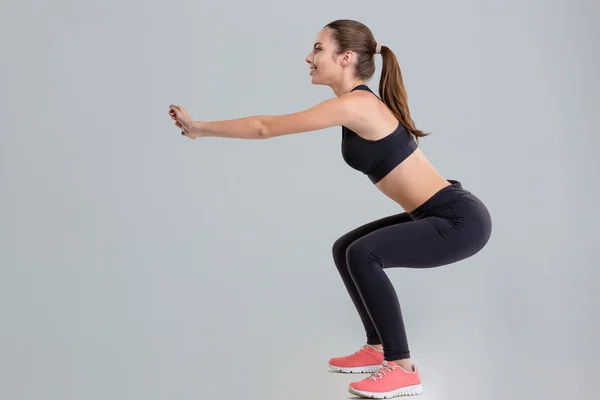
Squats–
Squats are a fundamental exercise that targets multiple muscle groups, primarily focusing on the thighs, hips, and buttocks. Here’s a detailed look at squats, including their benefits, variations, and proper form.
Benefits of Squats
- Strength and Muscle Development: Squats primarily target the quadriceps, hamstrings, and glutes, helping build muscle and strength in these areas.
- Core Stability: Performing squats engages the core muscles, improving overall stability and balance.
- Improved Mobility and Flexibility: Regular squatting can enhance the range of motion in the hips and ankles.
- Burning Calories: Squats are a compound exercise that can help burn a significant amount of calories.
- Functional Fitness: Squats mimic everyday movements like sitting and standing, making them practical for daily activities.
- Hormone Release: Heavy squats can stimulate the release of growth hormone and testosterone, which are essential for muscle growth and overall fitness.
Proper Squat Form
- Starting Position: Stand with your feet shoulder-width apart, toes pointing slightly outward. Keep your chest up, shoulders back, and engage your core.
- Movement: Begin by pushing your hips back as if you’re sitting in a chair. Bend your knees and lower your body, keeping your chest lifted and back straight.
- Depth: Lower yourself until your thighs are at least parallel to the ground. For a deeper squat, go as low as your flexibility allows while maintaining proper form.
- Ascent: Push through your heels to return to the starting position, fully extending your hips and knees.
Common Squat Variations
- Bodyweight Squat: Perform squats using only your body weight for resistance. Great for beginners and as a warm-up.
- Goblet Squat: Hold a dumbbell or kettlebell close to your chest while performing the squat.
- Back Squat: Place a barbell across your upper back and shoulders. This variation allows for heavier weights and greater muscle activation.
- Front Squat: Hold a barbell across the front of your shoulders. This targets the quadriceps more intensely and requires greater core strength.
- Overhead Squat: Hold a barbell or dumbbell overhead while performing the squat. This variation challenges your balance and shoulder stability.
- Sumo Squat: Stand with your feet wider than shoulder-width apart and toes pointing outwards. This targets the inner thighs more.
Tips for Effective Squats
- Warm-Up: Always warm up before squatting to prevent injuries and improve performance.
- Proper Footwear: Wear shoes with a flat, stable sole to ensure proper form and balance.
- Start Light: If you’re new to squatting, start with bodyweight squats and gradually increase the weight as you become more comfortable.
- Mind-Muscle Connection: Focus on engaging the targeted muscles throughout the movement.
- Controlled Movement: Perform the exercise in a controlled manner, avoiding any jerky or rapid movements.
Safety Considerations
- Avoid Knee Collapse: Ensure your knees do not cave inward during the squat. Keep them aligned with your toes.
- Maintain a Neutral Spine: Avoid rounding your back. Keep your spine neutral to prevent lower back injuries.
- Depth: Do not compromise form for depth. Only squat as low as you can maintain proper technique.
- Breathing: Inhale as you lower your body and exhale as you push back up.
Deadlifts
Deadlifts are a powerful compound exercise that engages multiple muscle groups, primarily focusing on the lower back, glutes, hamstrings, and core. Here’s an in-depth look at deadlifts, including their benefits, variations, and proper form.
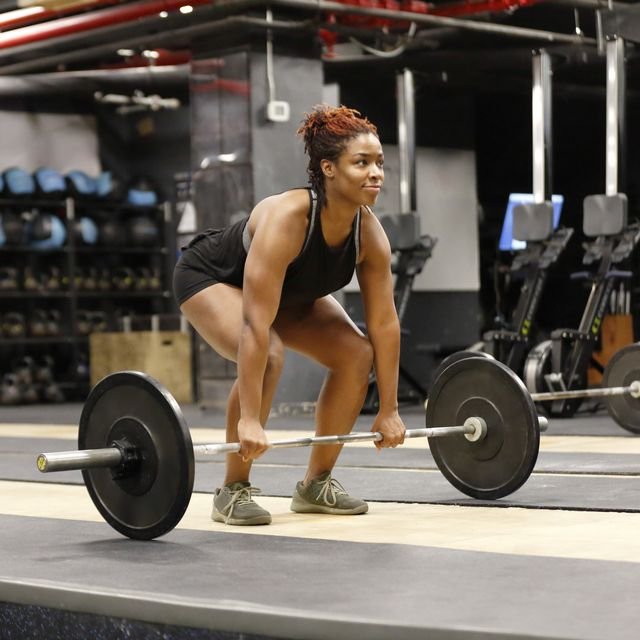
Benefits of Deadlifts
- Full-Body Strength: Deadlifts target numerous muscles, including the back, glutes, hamstrings, core, and even grip strength.
- Functional Fitness: The movement mimics real-life lifting situations, enhancing functional strength and daily activity performance.
- Hormone Release: Heavy deadlifting stimulates the release of growth hormone and testosterone, aiding in muscle growth and overall strength.
- Core Stability: Deadlifts engage and strengthen the core muscles, improving overall stability and balance.
- Posture Improvement: Strengthening the back and core helps improve posture and reduce the risk of lower back pain.
- Calorie Burning: Deadlifts are a high-intensity exercise that can help burn significant calories and contribute to fat loss.
Proper Deadlift Form
- Starting Position:
- Stand with your feet hip-width apart, toes pointing slightly outward.
- Place the barbell over the mid-foot, close to your shins.
- Bend at the hips and knees to grasp the bar with a shoulder-width grip, using either a double overhand grip or mixed grip (one hand overhand, one hand underhand).
- Setup:
- Lower your hips until your shins touch the bar.
- Keep your back straight, chest up, and shoulders slightly in front of the bar.
- Engage your core and take a deep breath.
- Lift:
- Drive through your heels and extend your hips and knees simultaneously to lift the bar.
- Keep the bar close to your body, maintaining a straight back.
- Stand up straight at the top of the lift, squeezing your glutes and engaging your core.
- Descent:
- Hinge at the hips and lower the bar slowly, keeping it close to your body.
- Bend your knees once the bar passes them, returning to the starting position.
Common Deadlift Variations
- Conventional Deadlift: The standard form of deadlifting, engaging the entire posterior chain.
- Sumo Deadlift: Stance is wider, toes pointing out, and hands grip the bar inside the knees. This variation targets the inner thighs and reduces lower back strain.
- Romanian Deadlift: Focuses on the hamstrings and glutes by keeping the legs slightly bent and emphasizing the hip hinge.
- Trap Bar Deadlift: Uses a trap (hex) bar, allowing for a more upright posture and reducing lower back strain.
- Snatch Grip Deadlift: Uses a wider grip, increasing the range of motion and targeting the upper back more intensely.
- Deficit Deadlift: Performed while standing on a platform or plate, increasing the range of motion and engaging the muscles more deeply.
Tips for Effective Deadlifts
- Warm-Up: Always warm up thoroughly before deadlifting to prevent injuries.
- Proper Footwear: Wear flat-soled shoes or deadlift shoes to ensure stability and proper form.
- Start Light: If you’re new to deadlifting, start with lighter weights and gradually increase as you become more comfortable with the form.
- Mind-Muscle Connection: Focus on engaging the targeted muscles throughout the lift.
- Controlled Movement: Perform the exercise with controlled movements, avoiding any jerky or rapid motions.
Safety Considerations
- Neutral Spine: Maintain a neutral spine throughout the lift to prevent lower back injuries.
- Avoid Rounding: Do not round your back, especially the lower back, during the lift.
- Grip Strength: Ensure your grip is secure to prevent the bar from slipping.
- Breathing: Inhale before lifting and exhale at the top of the lift. Avoid holding your breath throughout the entire movement.
- Listen to Your Body: Stop immediately if you feel any pain or discomfort in your lower back or other areas.
Push-Ups
Push-ups are a classic bodyweight exercise that primarily targets the chest, shoulders, and triceps. They are versatile, requiring minimal equipment and offering several variations to suit different fitness levels and goals. Here’s an overview of push-ups, including their benefits, variations, and proper form.

Benefits of Push-Ups
- Upper Body Strength: Push-ups build strength in the chest, shoulders, and triceps, promoting muscle growth and endurance.
- Core Stability: The exercise engages the core muscles, including the abdominals and lower back, improving overall stability and balance.
- Functional Fitness: Push-ups mimic everyday movements like pushing objects or getting up from the ground, making them practical for daily activities.
- Improved Joint Health: They help strengthen the muscles around the shoulders and reduce the risk of shoulder injuries.
- No Equipment Needed: Push-ups require no special equipment, making them accessible and convenient for home workouts or when traveling.
Proper Push-Up Form
- Starting Position:
- Begin in a prone position on the floor, with your hands slightly wider than shoulder-width apart.
- Extend your legs straight behind you, balancing on your toes.
- Your body should form a straight line from your head to your heels, with your core engaged.
2. Movement:
- Lower your body by bending your elbows, keeping them close to your sides.
- Lower yourself until your chest nearly touches the ground or until your elbows form a 90-degree angle.
- Keep your body in a straight line throughout the movement.
3. Ascent:
- Push through your palms and extend your elbows to raise your body back to the starting position.
- Keep your core engaged and avoid sagging your hips or arching your lower back.
4. Breathing:
- Inhale as you lower your body towards the ground.
- Exhale as you push yourself back up to the starting position.
Common Push-Up Variations
- Modified Push-Up (Knee Push-Up): Perform push-ups with your knees on the ground instead of your toes, reducing the load on the upper body.
- Wide Grip Push-Up: Place your hands wider than shoulder-width apart to emphasize the chest muscles.
- Close Grip Push-Up: Bring your hands closer together, directly under your shoulders, to target the triceps more intensely.
- Diamond Push-Up: Form a diamond shape with your hands directly under your chest, emphasizing the triceps and inner chest.
- Decline Push-Up: Elevate your feet on a stable platform (e.g., a bench or step), increasing the difficulty and targeting the upper chest and shoulders.
- Plyometric Push-Up: Push off forcefully enough to lift your hands off the ground, aiming for explosive power and upper body strength.
Tips for Effective Push-Ups
- Warm-Up: Always warm up before performing push-ups to prepare your muscles and joints.
- Proper Alignment: Maintain a straight line from head to heels throughout the exercise.
- Controlled Movement: Perform push-ups in a controlled manner, avoiding rapid or jerky movements.
- Full Range of Motion: Lower yourself until your chest nearly touches the ground for maximum muscle activation.
- Progression: Start with easier variations and gradually progress to more challenging ones as your strength improves.
Safety Considerations
- Avoid Sagging: Keep your core engaged to prevent your lower back from sagging during the exercise.
- Listen to Your Body: Stop immediately if you feel any pain or discomfort in your shoulders, wrists, or lower back.
- Breathing: Maintain a steady breathing pattern throughout the exercise to optimize oxygen flow to your muscles.
Pull-Ups
Pull-ups are a challenging upper-body exercise that primarily targets the back, shoulders, and arms. They require upper body strength and are an excellent bodyweight exercise for building muscle and improving overall fitness. Here’s an overview of pull-ups, including their benefits, variations, and proper form.

Benefits of Pull-Ups
- Back and Arm Strength: Pull-ups primarily target the latissimus dorsi (lats), rhomboids, and biceps, helping to build strength and muscle mass in the upper body.
- Core Engagement: Pull-ups engage the core muscles to stabilize the body throughout the movement.
- Improved Grip Strength: Performing pull-ups helps to strengthen the muscles of the forearms and hands, improving grip strength.
- Functional Fitness: The exercise mimics real-life pulling motions, making it beneficial for activities that involve lifting or pulling.
- Scapular Stability: Pull-ups promote scapular (shoulder blade) stability and mobility, which is essential for overall shoulder health.
Proper Pull-Up Form
Starting Position:
- Grip an overhead bar with your palms facing away from you (pronated grip).
- Hands should be slightly wider than shoulder-width apart.
- Hang from the bar with your arms fully extended and feet off the ground.
Movement:
- Engage your core muscles and pull yourself upward by bending your elbows.
- Aim to bring your chin above the bar or as high as you can comfortably go.
- Keep your body straight without swinging or kicking.
Descent:
- Lower yourself back down in a controlled manner, fully extending your arms.
- Avoid dropping suddenly or swinging excessively.
Breathing:
- Inhale as you lower yourself down.
- Exhale as you pull yourself up.
Common Pull-Up Variations
- Chin-Ups: Grip the bar with your palms facing towards you (supinated grip). This variation emphasizes the biceps more than the standard pull-up.
- Wide Grip Pull-Ups: Place your hands wider than shoulder-width apart to target the outer back muscles (lats) more intensely.
- Close Grip Pull-Ups: Bring your hands closer together, directly under your shoulders, to target the inner back muscles (rhomboids and middle traps).
- Assisted Pull-Ups: Use a resistance band looped around the bar and under your feet or knees to provide assistance as you pull yourself up.
- Weighted Pull-Ups: Attach a weight belt or hold a dumbbell between your feet to add resistance and increase the difficulty of the exercise.
- L-sit Pull-Ups: Keep your legs straight and raise them to form an L-shape while performing pull-ups, increasing core engagement.
Tips for Effective Pull-Ups
- Warm-Up: Always warm up before performing pull-ups to prepare your muscles and joints.
- Proper Grip: Ensure a secure grip on the bar to prevent slipping or injury.
- Full Range of Motion: Aim to pull your chin above the bar for a complete range of motion.
- Controlled Movement: Perform pull-ups in a controlled manner, avoiding swinging or jerking motions.
- Progression: Start with easier variations (e.g., assisted pull-ups) and gradually progress to more challenging ones as your strength improves.
Safety Considerations
- Avoid Kipping: While kipping pull-ups involve using momentum to swing the body, traditional pull-ups emphasize controlled strength and muscle engagement.
- Listen to Your Body: Stop immediately if you feel any pain or discomfort in your shoulders, elbows, or wrists.
- Breathing: Maintain a steady breathing pattern throughout the exercise to optimize oxygen flow to your muscles.
Lunges
Lunges are a versatile lower body exercise that targets the quadriceps, hamstrings, glutes, and calves. They help improve lower body strength, stability, and balance. Here’s a detailed look at lunges, including their benefits, variations, and proper form.
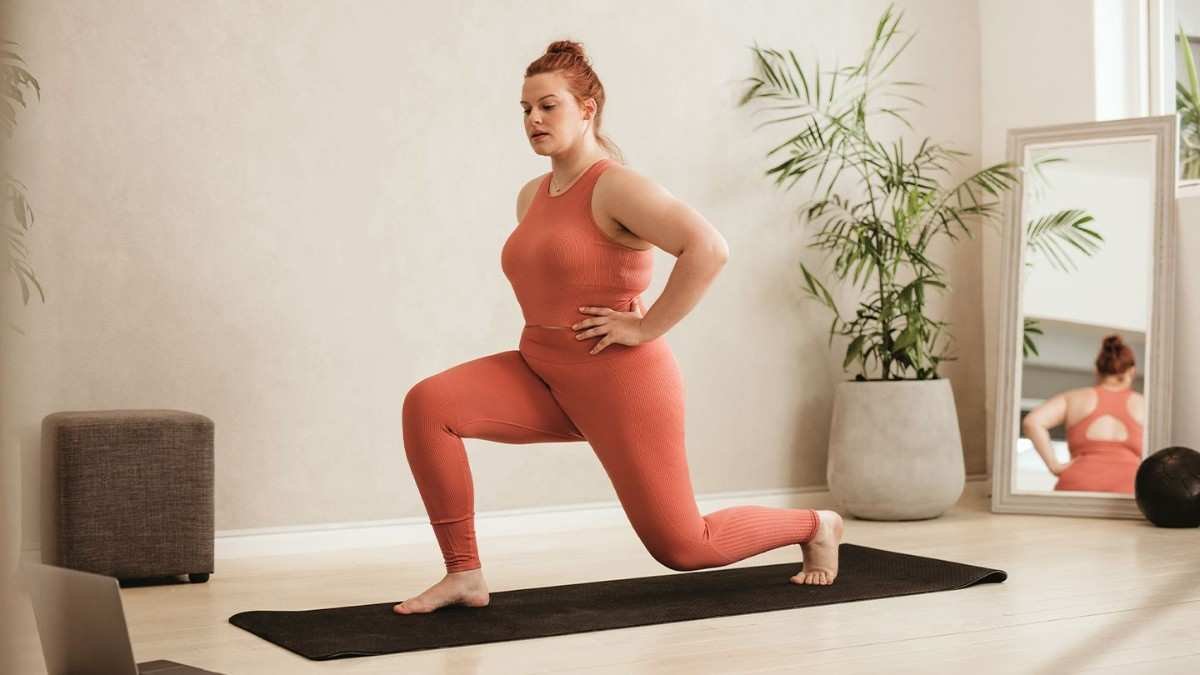
Benefits of Lunges
- Leg Strength: Lunges primarily target the muscles of the legs, including the quadriceps (front of thighs), hamstrings (back of thighs), and glutes (buttocks).
- Improved Balance and Stability: Lunges require core engagement and help improve balance and stability, which is beneficial for everyday activities and sports performance.
- Functional Movement: Lunges mimic movements like walking and climbing stairs, making them practical for daily living.
- Flexibility: Performing lunges can improve flexibility in the hips and legs, enhancing the overall range of motion.
- Can Be Done Anywhere: Lunges require minimal space and no equipment, making them suitable for home workouts or while traveling.
Proper Lunge Form
- Starting Position:
- Stand tall with your feet hip-width apart.
- Engage your core muscles and maintain a straight back throughout the exercise.
Forward Lunge:
- Take a step forward with one leg, keeping your torso upright.
- Lower your body until both knees are bent at a 90-degree angle, with the front knee aligned with your ankle.
- The back knee should hover just above the ground but not touch it.
- Keep your weight in the heel of your front foot as you push back to the starting position.
Reverse Lunge:
- Step backward with one leg, lowering your body until both knees are bent at a 90-degree angle.
- Keep your torso upright and ensure your front knee does not extend past your toes.
- Push through the heel of your front foot to return to the starting position.
Walking Lunge:
- Take a step forward with one leg into a lunge position.
- Instead of returning to the starting position, step forward with the opposite leg into another lunge.
- Continue alternating legs as you move forward.
Lateral Lunge:
- Step to the side with one leg, bending the knee and lowering your body into a lateral lunge.
- Keep the opposite leg straight and the toes pointing forward.
- Push through the heel of the bent leg to return to the starting position.
Common Lunge Variations
- Pulse Lunges: Add small pulses at the bottom of the lunge to increase time under tension and muscle engagement.
- Jumping Lunges: Perform a lunge and switch legs explosively in mid-air, alternating legs with each jump.
- Curtsy Lunges: Cross one leg behind the other and lunge down, targeting the glutes and inner thighs more intensely.
- Split Squat: Instead of stepping forward or backward, keep one foot on a bench or step behind you while you lunge with the other leg.
Tips for Effective Lunges
- Warm-Up: Always warm up before performing lunges to prepare your muscles and joints.
- Proper Alignment: Maintain proper form with each lunge, keeping your torso upright and avoiding excessive forward lean.
- Full Range of Motion: Lower your body until your knees are bent at approximately 90 degrees for maximum muscle activation.
- Controlled Movement: Perform lunges in a controlled manner, avoiding jerky or rapid movements.
- Balance: Use a chair or wall for balance if needed, especially when starting out or performing more challenging variations.
Safety Considerations
- Knee Alignment: Ensure your front knee does not extend past your toes during the lunge to prevent knee strain.
- Back Alignment: Keep your back straight and avoid arching or rounding your spine during the exercise.
- Steady Breathing: Maintain a steady breathing pattern throughout the exercise to optimize oxygen flow to your muscles.
Burpees
Burpees are a full-body exercise that combines elements of strength training and aerobic conditioning. They are highly effective for improving cardiovascular fitness, muscle endurance, and overall body conditioning. Here’s a comprehensive overview of burpees, including their benefits, variations, and proper form.
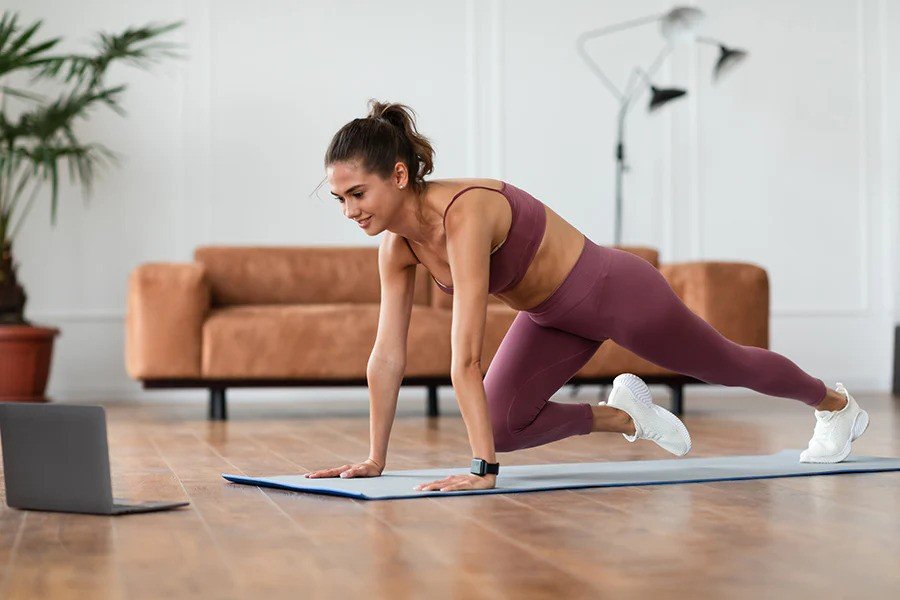
Benefits of Burpees
- Cardiovascular Conditioning: Burpees elevate your heart rate quickly, providing cardiovascular benefits similar to high-intensity interval training (HIIT).
- Full-Body Workout: Burpees engage multiple muscle groups, including the chest, arms, shoulders, core, and legs.
- Calorie Burning: Due to their high intensity, burpees can help burn a significant amount of calories in a short amount of time, aiding in weight loss.
- Strength Development: Burpees build strength in the upper body, core, and lower body, improving overall muscle tone and endurance.
- Functional Fitness: The exercise mimics movements like jumping, squatting, and push-ups, making it practical for improving everyday functional movements.
- No Equipment Needed: Burpees require no equipment, making them accessible for home workouts or when traveling.
Proper Burpee Form
Starting Position:
- Stand with your feet shoulder-width apart, arms at your sides.
Movement:
- Lower into a squat position, placing your hands on the floor in front of you.
- Kick your feet back into a plank position, keeping your arms extended.
- Perform a push-up, lowering your chest to the floor if possible.
- Jump your feet back to the squat position.
- Explosively jump up into the air, reaching your arms overhead.
Repetition:
- Land softly and immediately lower into the next repetition.
- Aim for a controlled yet dynamic pace to maintain intensity throughout the set.
Common Burpee Variations
- Modified Burpees: Perform without the push-up or jump to reduce intensity, suitable for beginners or those with joint concerns.
- Burpee with a Box Jump: Instead of jumping straight up, jump onto a sturdy box or platform at the top of the movement.
- Single-Leg Burpees: Perform the burpee with one leg lifted off the ground throughout the movement, alternating legs with each repetition.
- Burpee Pull-Ups: Perform a burpee under a pull-up bar, then jump up and perform a pull-up at the top of the movement.
- Burpee Tuck Jumps: Instead of a standard jump, bring your knees up towards your chest during the jump phase of the burpee.
Tips for Effective Burpees
- Warm-Up: Always warm up before performing burpees to prepare your muscles and joints.
- Proper Alignment: Maintain a neutral spine throughout the exercise, avoiding arching or rounding your back.
- Controlled Movement: Perform each phase of the burpee in a controlled manner to reduce the risk of injury.
- Pacing: Start with a manageable pace and gradually increase intensity as your fitness level improves.
- Breathing: Focus on breathing rhythmically throughout the exercise, inhaling during the squat and exhaling during the jump.
Safety Considerations
- Modify as Needed: If you have any injuries or limitations, modify the burpee to suit your fitness level or consult with a fitness professional for alternatives.
- Proper Footwear: Wear supportive shoes to cushion landings and provide stability during the jumping phase.
- Surface: Perform burpees on a non-slip surface to reduce the risk of slipping or injury.
Planks
These exercises are a great way to build core strength, improve stability, and enhance overall fitness. Planks are known for their effectiveness in building core stability and endurance. Here’s a detailed look at planks, including their benefits, variations, and proper form.
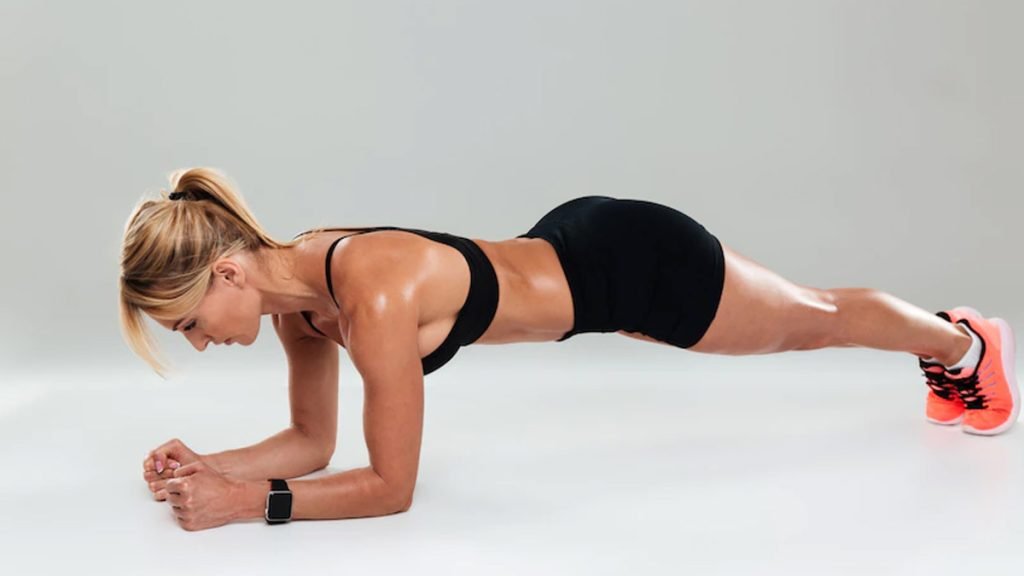
Benefits of Planks
Core Strength: Core strength involves the muscles in your abdomen, lower back, and pelvis, providing stability, balance, and overall body strength.
Improved Posture: Strengthening the core muscles helps improve overall posture. And reduce the risk of back pain.
Increased Stability: These exercises enhance core stability, which is essential for performing daily activities and athletic movements.
Balance and Coordination: Holding a plank position improves balance and coordination by requiring you to stabilize your body.
Versatility: These can be modified to suit different fitness levels and can be done anywhere with no equipment.
Proper Plank Form
Starting Position:
- Begin on the floor in a prone position, facing downward.
- Place your forearms on the ground, elbows directly beneath your shoulders.
- Extend your legs straight behind you, balancing on your toes.
- Keep your body in a straight line from head to heels, engaging your core muscles.
Hold the Position:
- Maintain a neutral spine and avoid sagging or arching your back.
- Keep your head in line with your spine, looking down at the floor.
- Hold the plank position for as long as you can while maintaining proper form and breathing rhythmically.
Common Plank Variations
Forearm Plank: Standard plank position on your forearms and toes.
High Plank: Plank position with arms fully extended, balancing on your hands and toes.
Side Plank: Balance on one forearm or hand and the side of one foot, lifting your hips to form a straight line from head to heels.
Shoulder Taps with Plank: While holding a plank, alternately tap each shoulder with the opposite hand, engaging the core to maintain stability.
Leg Lifts With Plank: Lift one leg off the ground while holding a plank position, alternating legs to engage the glutes and lower back more intensely.
Plank Jacks: Start in a high plank position and jump your feet wide apart and then back together, engaging the core and legs dynamically.
Tips for Effective Planks
Warm-Up: Always warm up before performing planks to prepare your core muscles and prevent injury.
Proper Alignment: Maintain a straight line from head to heels throughout the exercise, avoiding sagging hips or arching the lower back.
Breathing: Breathe deeply and rhythmically throughout the exercise to maintain oxygen flow to your muscles.
Gradual Progression: Start with shorter hold times and gradually increase duration as your core strength improves.
Quality Over Quantity: Focus on maintaining proper form rather than holding the plank position for an extended period with compromised form.
Safety Considerations
- Avoid Overarching: Keep your core engaged and pelvis tucked under to avoid excessive strain on the lower back.
- Modify as Needed: If you experience discomfort or pain in your wrists, shoulders, or lower back, modify the plank position or consult with a fitness professional.
- Surface: Perform planks on a comfortable surface to protect your elbows and maintain stability.
Rowing
Rowing is an excellent full-body exercise that provides cardiovascular benefits while also engaging multiple muscle groups. It mimics the action of rowing a boat and can be performed on various types of rowing machines or on water. Here’s a comprehensive look at rowing, including its benefits, techniques, and variations.
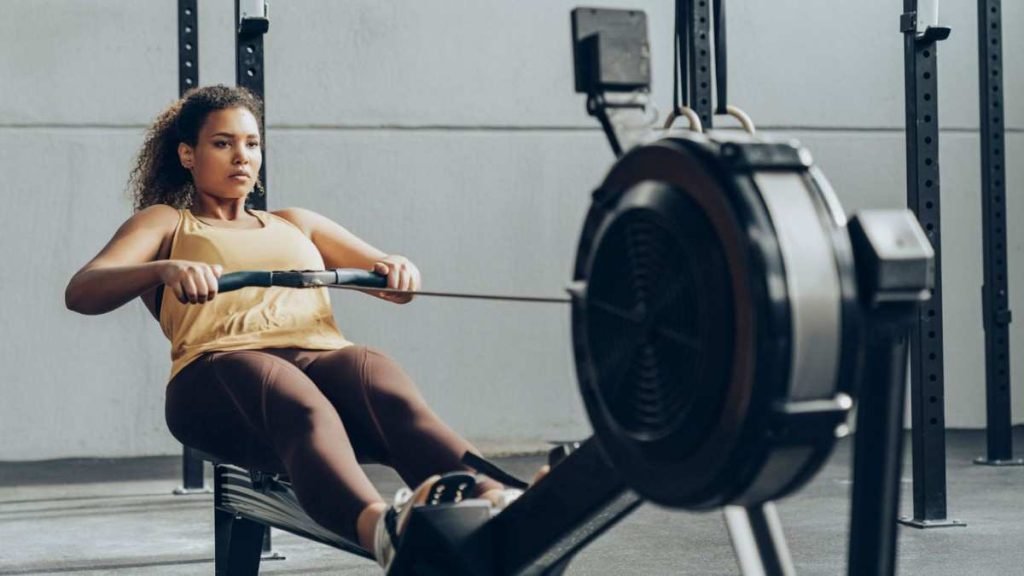
Benefits of Rowing
- Cardiovascular Fitness: Rowing is a dynamic aerobic exercise that elevates the heart rate and improves cardiovascular endurance.
- Full-Body Workout: It engages multiple muscle groups, including the legs, back, core, arms, and shoulders, providing a comprehensive workout.
- Low-Impact Exercise: Rowing is gentle on the joints, making it suitable for individuals of all fitness levels and ages.
- Calorie Burning: Rowing can help burn a significant amount of calories per hour, aiding in weight loss and management.
- Muscle Toning: The pulling motion of rowing strengthens and tones muscles throughout the body, promoting muscle development and definition.
- Improves Posture: Rowing promotes proper posture by strengthening the back muscles and core, which helps counteract the effects of prolonged sitting.
Proper Rowing Technique (Using a Rowing Machine)
- Starting Position:
- Sit on the rowing machine with your feet secured in the foot straps, knees bent, and shins vertical.
- Grab the handle with an overhand grip, keeping your arms extended, shoulders relaxed, and core engaged.
Drive Phase:
- Push through your legs to extend them while simultaneously leaning back slightly.
- Pull the handle towards your lower chest, driving your elbows back and squeezing your shoulder blades together.
Finish Position:
- Lean back slightly, with the handle pulled towards your lower chest, elbows close to your body.
- Your legs should be extended, and you should be leaning back comfortably, engaging your core.
Recovery Phase:
- Extend your arms forward, allowing the handle to move away from your body.
- Bend your knees and slide back to the starting position smoothly.
Breathing:
- Inhale during the recovery phase (forward motion).
- Exhale during the drive phase (pulling motion).
Common Rowing Machine Variations
- Resistance Levels: Adjust the resistance on the rowing machine to increase or decrease the intensity of your workout.
- Interval Training: Alternate between periods of high-intensity rowing and active recovery to enhance cardiovascular fitness and calorie burning.
- Rowing Sprints: Row at a high intensity for short bursts (e.g., 30 seconds to 1 minute) followed by rest periods or light rowing.
- Long Rowing Sessions: Maintain a steady pace for longer durations to build endurance and stamina.
Tips for Effective Rowing
- Warm-Up: Begin with a light warm-up to prepare your muscles and joints for the rowing motion.
- Proper Form: Focus on maintaining proper technique throughout each stroke to maximize efficiency and reduce the risk of injury.
- Engage the Core: Keep your core muscles engaged throughout the entire rowing motion to support your back and maintain stability.
- Monitor Stroke Rate: Pay attention to your stroke rate (strokes per minute) and adjust as needed to maintain a consistent pace or vary intensity.
- Cool Down: Finish your rowing session with a cool-down period to gradually lower your heart rate and stretch your muscles.
Safety Considerations
- Start Slowly: If you’re new to rowing, start with shorter sessions and gradually increase duration and intensity as your fitness improves.
- Consult a Trainer: If using a rowing machine for the first time, consider consulting a fitness professional to learn the proper technique and settings.
- Hydration and Nutrition: Stay hydrated before, during, and after your rowing session. And fuel your body with adequate nutrition to support your workout.
Kettlebell Swings
Kettlebell swings are a dynamic and effective exercise. That targets multiple muscle groups while providing cardiovascular benefits. They involve swinging a kettlebell between the legs and up to chest or shoulder height, utilizing the force generated by the hips and legs. Here’s an overview of kettlebell swings, including their benefits, proper form, and variations.
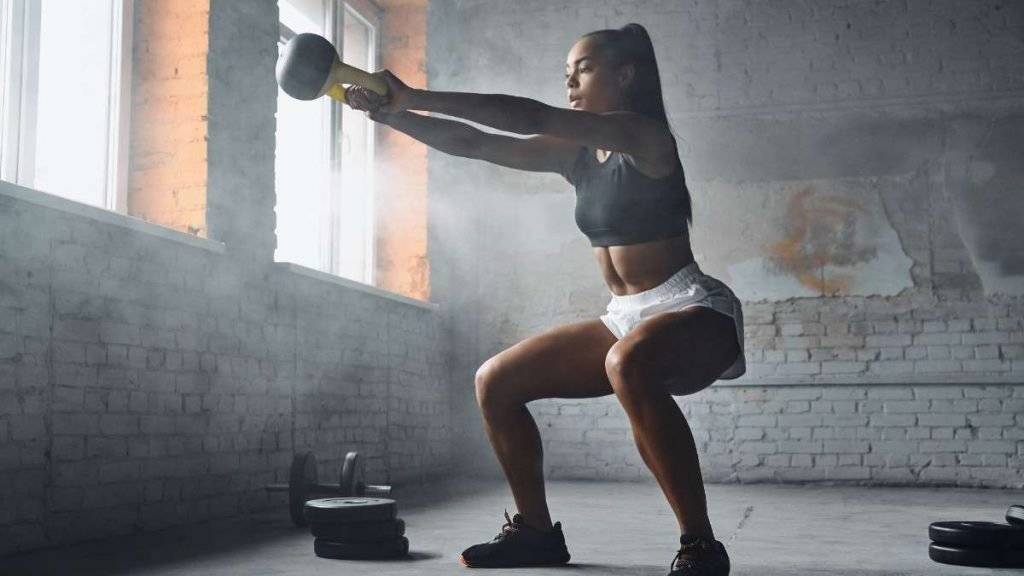
Benefits of Kettlebell Swings
- Full-Body Workout: Kettlebell swings engage multiple muscles including the hips, glutes, hamstrings, core, shoulders, and back.
- Cardiovascular Conditioning: They elevate the heart rate quickly, making them effective for cardiovascular fitness and calorie burning.
- Explosive Power: Swinging the kettlebell builds explosive power in the hips and legs, beneficial for sports and functional movements.
- Improved Posture and Stability: Proper execution of swings helps strengthen the posterior chain and core, enhancing overall stability and posture.
- Time Efficiency: Kettlebell swings can provide a comprehensive workout in a short amount of time, combining strength and cardio training.
Proper Kettlebell Swing Form
- Starting Position:
- Stand with your feet shoulder-width apart, toes pointed slightly outward.
- Place the kettlebell on the floor slightly in front of you.
- Hinge at your hips to reach for the kettlebell with both hands, keeping your back flat and chest up.
Swinging Motion:
- Grasp the kettlebell with both hands, maintaining a firm grip.
- Swing the kettlebell back between your legs while keeping your arms extended.
- Quickly reverse the motion by driving your hips forward explosively.
- Swing the kettlebell up to chest or shoulder height, using the momentum generated by your hips and legs.
- Keep your core engaged throughout the movement to stabilize your spine.
Finish Position:
- At the top of the swing, the kettlebell should reach chest or shoulder height.
- Your arms should be extended, and your body should form a straight line from head to heels.
- Control the descent of the kettlebell back between your legs as you hinge at the hips.
Repetition:
- Continue swinging the kettlebell back and forth in a controlled manner, maintaining proper form and breathing rhythmically.
Common Kettlebell Swing Variations
- Two-Handed Kettlebell Swing: Standard swing using both hands to grip the kettlebell.
- One-Handed Kettlebell Swing: Perform swings while gripping the kettlebell with one hand, alternating hands with each swing.
- American Kettlebell Swing: Swing the kettlebell overhead until your arms are fully extended vertically, emphasizing shoulder strength and mobility.
- Russian Kettlebell Swing: Swing the kettlebell to chest height, focusing on the explosive hip hinge movement without extending the arms overhead.
- Bottoms-Up Kettlebell Swing: Hold the kettlebell upside down by the handle and perform swings, requiring greater grip strength and forearm stabilization.
Tips for Effective Kettlebell Swings
- Warm-Up: Begin with a dynamic warm-up to prepare your muscles and joints for the swinging motion.
- Hip Hinge: Focus on hinging at your hips rather than squatting down to lift the kettlebell, emphasizing the posterior chain.
- Core Engagement: Keep your core muscles engaged throughout the entire movement to protect your lower back and stabilize your spine.
- Breathing: Inhale as you swing the kettlebell back between your legs and exhale forcefully as you drive your hips forward during the swing.
- Start Light: Begin with a lighter kettlebell to master the proper technique before gradually increasing the weight.
Safety Considerations
- Proper Technique: Ensure you have mastered the basic form of kettlebell swings before progressing to more advanced variations.
- Clear Space: Perform kettlebell swings in an open space with enough room to swing the kettlebell without obstruction.
- Footwear: Wear supportive shoes with good grip to maintain stability during the swinging motion.
Mountain Climbers
Mountain climbers are a dynamic and intense exercise that engages multiple muscle groups, particularly the core, shoulders, and legs. They are known for their cardiovascular benefits and ability to improve endurance. Here’s an overview of mountain climbers, including their benefits, proper form, and variations.
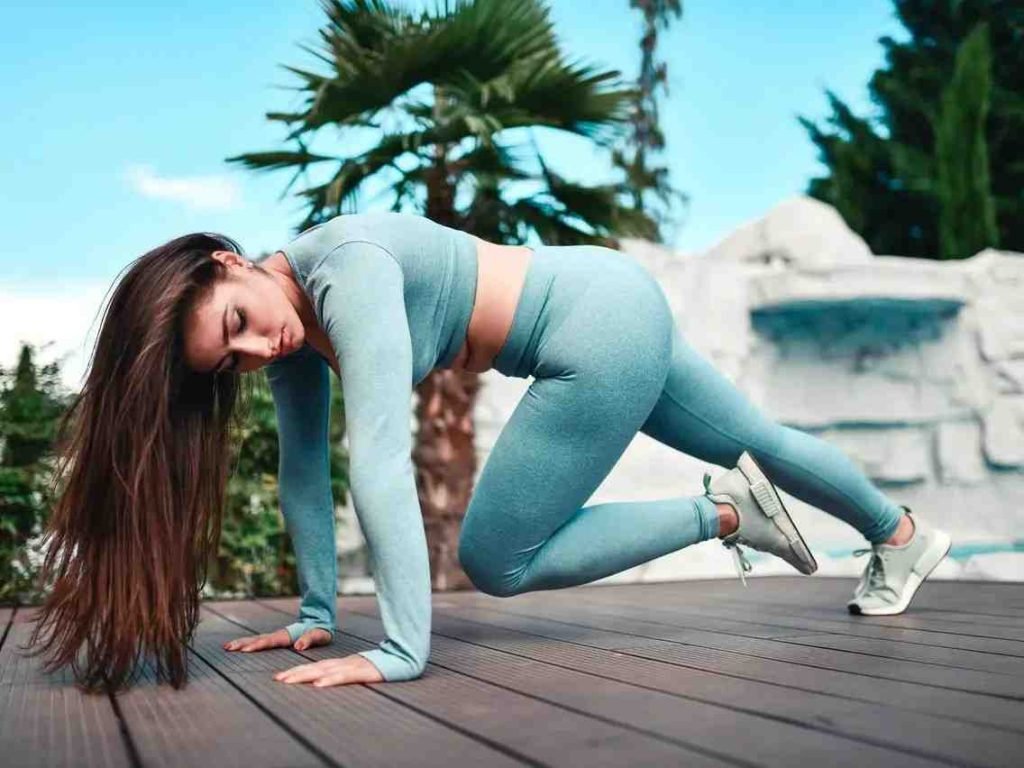
Benefits of Mountain Climbers
- Cardiovascular Conditioning: Mountain climbers elevate the heart rate quickly, providing effective cardiovascular exercise and calorie burning.
- Full-Body Workout: They engage multiple muscle groups, including the core, shoulders, chest, and legs, promoting overall strength and muscle tone.
- Core Strength: Mountain climbers require core stabilization throughout the exercise, helping to strengthen abdominal muscles and improve posture.
- Improved Agility and Coordination: Performing mountain climbers enhances agility and coordination by requiring synchronization of movements between the upper and lower body.
- Time Efficiency: They can be performed as part of a high-intensity interval training (HIIT) workout or incorporated into a circuit for efficient total-body conditioning.
Proper Mountain Climber Form
- Starting Position:
- Begin in a plank position with your hands directly under your shoulders and your body forming a straight line from head to heels.
- Engage your core muscles to maintain stability throughout the exercise.
Movement:
- Drive one knee towards your chest, keeping the other leg extended and toes on the ground.
- Quickly switch legs, bringing the opposite knee towards your chest. While extending the first leg back.
- Alternate legs in a rapid, running-like motion, maintaining a steady pace.
Speed and Tempo:
- Perform mountain climbers at a controlled and steady pace, focusing on maintaining proper form throughout.
- Increase speed for a higher-intensity workout or slow down to focus on muscle engagement and stability.
Breathing:
- Breathe deeply and rhythmically throughout the exercise, coordinating your breath with each leg movement.
- Inhale as you extend your leg back and exhale as you drive your knee towards your chest.
Common Mountain Climber Variations
- Cross-Body Mountain Climbers: Bring each knee towards the opposite elbow, engaging the obliques more intensely.
- Spiderman Mountain Climbers: Bring each knee towards the same-side elbow, emphasizing core rotation and hip flexibility.
- Mountain Climber Sliders: Perform mountain climbers with your feet on sliders or a smooth surface, increasing the challenge of stabilizing your core.
- Mountain Climber with Twist: As you bring each knee towards your chest, rotate your torso to the same side, alternating sides with each rep.
Tips for Effective Mountain Climbers
- Warm-Up: Begin with a light warm-up to prepare your muscles and joints for the dynamic movement of mountain climbers.
- Proper Alignment: Maintain a neutral spine, and avoid sagging or arching your back during the exercise.
- Core Engagement: Focus on keeping your core muscles engaged throughout the entire movement to stabilize your body.
- Steady Pace: Maintain a consistent tempo that allows you to perform mountain climbers with proper form and control.
- Gradual Progression: Start with shorter sets and gradually increase the duration or speed as your fitness level improves.
Safety Considerations
- Surface: Perform mountain climbers on a comfortable surface to protect your wrists and maintain stability.
- Modification: If you have wrist pain or discomfort, perform mountain climbing with your hands elevated on a step or bench to reduce wrist strain.
- Monitor Intensity: Adjust the speed and intensity of mountain climbers based on your fitness level and goals, focusing on maintaining proper form.
FAQs about full-body workouts
1. What is a full-body workout?
A full-body workout is a type of exercise routine that targets multiple muscle groups in a single session. It typically includes exercises that engage muscles throughout the entire body, from the upper body (chest, back, shoulders, arms) to the lower body (legs, glutes), and often includes core exercises as well.
2. What are the benefits of full-body workouts?
- Efficiency: Full-body workouts allow you to work all major muscle groups in one session, saving time compared to split routines.
- Improved Muscle Balance: They help maintain overall muscle balance and symmetry.
- Calorie Burning: Full-body workouts can be effective for burning calories and promoting weight loss.
- Functional Fitness: They improve overall strength, endurance, and coordination, which can benefit daily activities and sports performance.
- Variety and Flexibility: You can customize full-body workouts to include different exercises and equipment, making them adaptable to different fitness levels and goals.
3. How often should I do a full-body workout?
The frequency of full-body workouts depends on your fitness level, goals, and overall exercise routine. Generally:
- Beginners: Start with 2-3 full-body workouts per week to allow for proper recovery.
- Intermediate: Aim for 3-4 sessions per week, with at least one rest day between workouts.
- Advanced: You might do full-body workouts 4-5 times per week, incorporating varied intensity and exercises.
4. What exercises should I include in a full-body workout?
A well-rounded full-body workout typically includes exercises that target major muscle groups, such as:
- Upper Body: Push-ups, pull-ups, bench press, shoulder press, rows.
- Lower Body: Squats, lunges, deadlifts, leg presses.
- Core: Planks, crunches, Russian twists, leg raises.
- Cardiovascular: Burpees, jumping jacks, mountain climbers, rowing.
5. How long should a full-body workout session last?
The duration of a full-body workout can vary based on intensity, exercises chosen, and fitness level. Generally, a session might last anywhere from 30 minutes to an hour, including warm-up and cool-down periods.
6. Can I combine full-body workouts with other types of exercise?
Yes, you can incorporate full-body workouts with other types of exercise like cardio, yoga, or specific muscle group training (e.g., arms or abs). It’s essential to balance different types of workouts to prevent overtraining and promote overall fitness.
7. Should I use weights or bodyweight exercises for full-body workouts?
Both weights and bodyweight exercises can be effective for full-body workouts. Using weights (dumbbells, barbells, kettlebells) adds resistance to build strength, while bodyweight exercises (push-ups, squats, planks) can improve muscular endurance and require minimal equipment.
8. How do I know if a full-body workout is right for me?
Full-body workouts are suitable for most people, but it’s essential to consider your fitness goals, current fitness level, and any health concerns. Consult with a fitness professional or personal trainer to create a tailored workout plan that aligns with your needs and ensures proper form and technique.
9. What should I eat before and after a full-body workout?
Before a workout, consume a balanced meal or snack containing carbohydrates for energy and protein for muscle repair. Afterward, focus on replenishing with a combination of protein and carbohydrates to aid recovery. Hydration is also crucial before, during, and after exercise.
10. How can I avoid injury during full-body workouts?
To reduce the risk of injury during full-body workouts:
- Warm up properly with dynamic stretches or light cardio.
- Use proper form and technique for each exercise.
- Start with lighter weights or resistance if you’re new to strength training.
- Listen to your body and avoid overtraining or pushing through pain.
By following these guidelines and listening to your body’s cues, you can effectively incorporate full-body workouts into your fitness routine to achieve your health and fitness goals.
